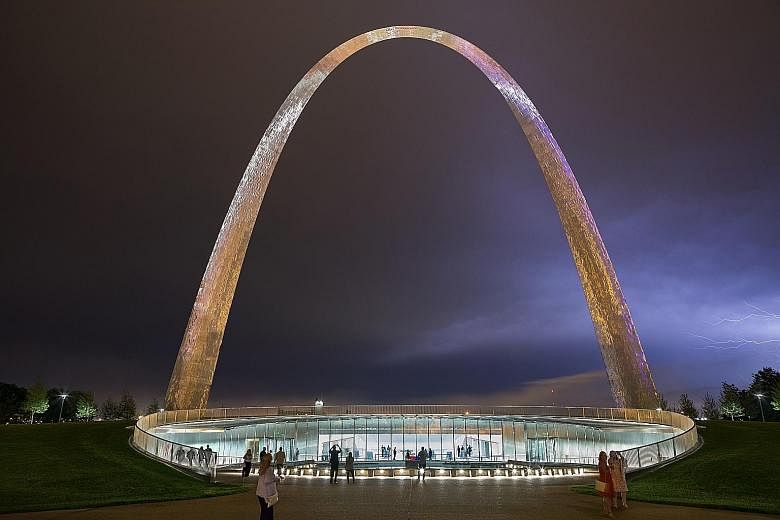ST LOUIS • One of America's most recognisable landmarks will be re-introduced to the world with a new name, a new museum and a substantial redesign of its urban landscape next Tuesday.
A half century after Eero Saarinen's Gateway Arch was inaugurated in 1968, it has been reconnected to the city of St Louis, with a sleek underground entrance facing the city, an expanded and redesigned visitor centre and museum, a cleaner landscape and an elevated and more elegant waterfront along the Mississippi River.
An old parking garage has been removed and a park-like pedestrian platform over Interstate 44 lets visitors from downtown St Louis visit the city's most popular attraction without having to brave traffic lanes.
But it is the new name that encapsulates the larger cultural changes to the National Park Service (NPS) site, which has been given a US$380-million (S$520-million) renovation and redesign.
What was once known as the Jefferson National Expansion Park has been recast as the Gateway Arch National Park. That change simply reflects how people think about the park, says Mr Eric Moraczewski, executive director of Gateway Arch Park Foundation, a non-profit group that partnered NPS to raise funds and oversee the renovation.
Standing on the grassy deck which crosses Interstate 44, Mr Moraczewski points to the nearby Hyatt hotel, where the concierge used to call taxis to ferry people to the arch grounds before the renovation.
"The arch operated as an island," he says. "Our island was about roads, not water, but people came to the arch and never went into the city."
The connecting park is not terribly wide - just shy of the 91m width which would have defined the structure as a tunnel, rather than a bridge, requiring costly ventilation and other mandated changes.
But it is wide enough to include trees and benches and arcing paths that attract a lunchtime crowd, dog walkers, joggers and tourists from the nearby hotels.
It also emphasises a connection between the arch and the historic courthouse which faces it, the courthouse where Dred Scott pursued his freedom from slavery, and where a Missouri judge decided that allowing an enslaved person to claim freedom because he resided in a free state would lead to the inevitable "overthrow and destruction of our government".
The arch grounds now flow seamlessly into the plaza that fronts the courthouse and lead visitors to the sunken, glass-walled entrance to the museum.
Before the design changes, there was nothing to indicate that the arch park had anything in it other than an arch, and visitors encountered the underground museum as a sideshow to the main attraction, which was a ride in the cramped and clanking lifts that deliver people to the observation room atop the 192m-tall structure.
Now, visitors are greeted by a semi-circular entrance, from which they descend into the museum via a large, open atrium with a terrazzo map of North America on the mezzanine floor, showing the main migration routes during the era of westward expansion.
The museum concludes with the design and construction of the arch itself, which was an urban renewal project that led to the loss of the colonial-era street grid, and hundreds of buildings, many erected in the 19th century.
Saarinen died in 1961, long after he won the 1947 design competition, and well before construction was completed in 1965.
WASHINGTON POST

